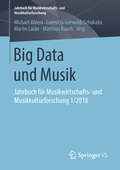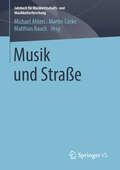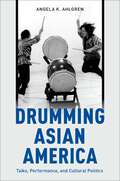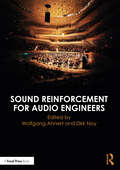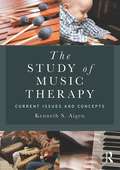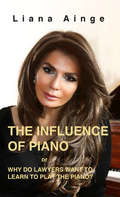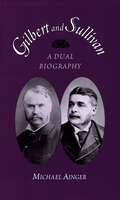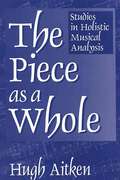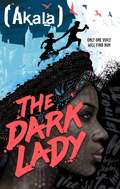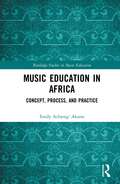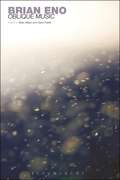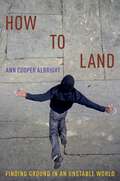- Table View
- List View
Big Data und Musik: Jahrbuch für Musikwirtschafts- und Musikkulturforschung 1/2018 (Jahrbuch für Musikwirtschafts- und Musikkulturforschung)
by Michael Ahlers Lorenz Grünewald-Schukalla Martin Lücke Matthias RauchBig Data ist nicht nur Sache von Versicherungen und Internetunternehmen. Auch für die global agierende Musikwirtschaft, die in den letzten knapp 20 Jahren bereits zahlreiche Transformationen überstehen musste, werden Sammlung, Analyse und Verwertung großer Datenmengen zu einem immer zentraleren Thema. Das aktuelle Jahrbuch der Gesellschaft für Musikwirtschafts- und Musikkulturforschung versammelt hierzu unterschiedliche Ansätze und Perspektiven auf das Thema Big Data und Musik: Von den Datafication-Algorithmen Spotifys über die rechtlichen Implikationen von Music Data Mining, die Blockchain oder der Nutzung von Big Data im Artist & Repertoire Management werden zentrale Anwendungsfelder von Musik und Big Data in den Blick genommen.
Perspectives on German Popular Music (Ashgate Popular and Folk Music Series)
by Michael Ahlers Christoph JackeIn this book, native popular musicologists focus on their own popular music cultures from Germany, Austria and Switzerland for the first time: from subcultural to mainstream phenomena; from the 1950s to contemporary acts. Starting with an introduction and two chapters on the histories of German popular music and its study, the volume then concentrates on focused, detailed and yet concise close readings from different perspectives (including particular historical East and West German perspectives), mostly focusing on the music and its protagonists. Moreover, these analyses deal with very original specific genres such as Schlager and Krautrock as well as transcultural genres such as Punk or Hip Hop. There are additional chapters on characteristically German developments within music media, journalism and the music industry. The book will contribute to a better understanding of German, Austrian and Swiss popular music, and will interconnect international and especially Anglo-American studies with German approaches. The book, as a consequence, will show close connections between global and local popular music cultures and diverse traditions of study.
Perspectives on German Popular Music (Ashgate Popular and Folk Music Series)
by Michael Ahlers Christoph JackeIn this book, native popular musicologists focus on their own popular music cultures from Germany, Austria and Switzerland for the first time: from subcultural to mainstream phenomena; from the 1950s to contemporary acts. Starting with an introduction and two chapters on the histories of German popular music and its study, the volume then concentrates on focused, detailed and yet concise close readings from different perspectives (including particular historical East and West German perspectives), mostly focusing on the music and its protagonists. Moreover, these analyses deal with very original specific genres such as Schlager and Krautrock as well as transcultural genres such as Punk or Hip Hop. There are additional chapters on characteristically German developments within music media, journalism and the music industry. The book will contribute to a better understanding of German, Austrian and Swiss popular music, and will interconnect international and especially Anglo-American studies with German approaches. The book, as a consequence, will show close connections between global and local popular music cultures and diverse traditions of study.
Musik und Straße (Jahrbuch für Musikwirtschafts- und Musikkulturforschung)
by Michael Ahlers Martin Lücke Matthias RauchDer Band versteht Straßen als Phänomene, Orte oder Dispositive: Durch praxeologische, inter- und transdisziplinäre Zugriffe finden sich sowohl Themen wie die Straßenmusik, berühmte Straßennamen selbst, sowie Marketingmaßnahmen, welche auf Straßen und urbanen Plätzen ihre Wirkung entfalten. Die Beispiele der Artikel reichen dabei von Zentral- und Ost-Europa bis nach Asien und Nordamerika.
Drumming Asian America: Taiko, Performance, and Cultural Politics
by Angela K. AhlgrenWith its dynamic choreographies and booming drumbeats, taiko has gained worldwide popularity since its emergence in 1950s Japan. Harnessed by Japanese Americans in the late 1960s, taiko's sonic largesse and buoyant energy challenged stereotypical images of Asians in America as either model minorities or sinister foreigners. While the majority of North American taiko players are Asian American, over 400 groups now exist across the US and Canada, and players come from a range of backgrounds. Using ethnographic and historical approaches, combined with in-depth performance description and analysis, this book explores the connections between taiko and Asian American cultural politics. Based on original and archival interviews, as well as the author's extensive experience as a taiko player, this book highlights the Midwest as a site for Asian American cultural production and makes embodied experience central to inquiries about identity, including race, gender, and sexuality. The book builds on insights from the fields of dance studies, ethnomusicology, performance studies, queer and feminist theory, and Asian American studies to argue that taiko players from a variety of identity positions perform Asian America on stage, as well as in rehearsals, festivals, schools, and through interactions with audiences. While many taiko players play simply for the love of its dynamism and physicality, this book demonstrates that politics are built into even the most mundane aspects of rehearsing and performing.
DRUMMING ASIAN AMERICA C: Taiko, Performance, and Cultural Politics
by Angela K. AhlgrenWith its dynamic choreographies and booming drumbeats, taiko has gained worldwide popularity since its emergence in 1950s Japan. Harnessed by Japanese Americans in the late 1960s, taiko's sonic largesse and buoyant energy challenged stereotypical images of Asians in America as either model minorities or sinister foreigners. While the majority of North American taiko players are Asian American, over 400 groups now exist across the US and Canada, and players come from a range of backgrounds. Using ethnographic and historical approaches, combined with in-depth performance description and analysis, this book explores the connections between taiko and Asian American cultural politics. Based on original and archival interviews, as well as the author's extensive experience as a taiko player, this book highlights the Midwest as a site for Asian American cultural production and makes embodied experience central to inquiries about identity, including race, gender, and sexuality. The book builds on insights from the fields of dance studies, ethnomusicology, performance studies, queer and feminist theory, and Asian American studies to argue that taiko players from a variety of identity positions perform Asian America on stage, as well as in rehearsals, festivals, schools, and through interactions with audiences. While many taiko players play simply for the love of its dynamism and physicality, this book demonstrates that politics are built into even the most mundane aspects of rehearsing and performing.
Sound Reinforcement for Audio Engineers
by Wolfgang AhnertSound Reinforcement for Audio Engineers illustrates the current state of the art in sound reinforcement. Beginning with an outline of various fields of applications, from sports venues to religious venues, corporate environments and cinemas, this book is split into 11 chapters covering room acoustics, loudspeakers, microphones and acoustic modelling among many other topics. This comprehensive book packed with references and a historical overview of sound reinforcement design is an essential reference book for students of acoustics and electrical engineering, but also for engineers looking to expand their knowledge of designing sound reinforcement systems.
Sound Reinforcement for Audio Engineers
by Wolfgang Ahnert Dirk NoySound Reinforcement for Audio Engineers illustrates the current state of the art in sound reinforcement. Beginning with an outline of various fields of applications, from sports venues to religious venues, corporate environments and cinemas, this book is split into 11 chapters covering room acoustics, loudspeakers, microphones and acoustic modelling among many other topics. This comprehensive book packed with references and a historical overview of sound reinforcement design is an essential reference book for students of acoustics and electrical engineering, but also for engineers looking to expand their knowledge of designing sound reinforcement systems.
The Tangible in Music: The Tactile Learning of a Musical Instrument (SEMPRE Studies in The Psychology of Music)
by Marko AhoIn the age of digital music it seems striking that so many of us still want to produce music concretely with our bodies, through the movement of our limbs, lungs and fingers, in contact with those materials and objects which are capable of producing sounds. The huge sales figures of musical instruments in the global market, and the amount of time and effort people of all ages invest in mastering the tools of music, make it clear that playing musical instruments is an important phenomenon in human life. By combining the findings made in music psychology and performative ethnomusicology, Marko Aho shows how playing a musical instrument, and the pleasure musicians get from it, emerges from an intimate dialogue between the personally felt body and the sounding instrument. An introduction to the general aspects of the tactile resources of musical instruments, musical style and the musician is followed by an analysis of the learning process of the regional kantele style of the Perho river valley in Finnish Central Ostrobothnia.
The Tangible in Music: The Tactile Learning of a Musical Instrument (SEMPRE Studies in The Psychology of Music)
by Marko AhoIn the age of digital music it seems striking that so many of us still want to produce music concretely with our bodies, through the movement of our limbs, lungs and fingers, in contact with those materials and objects which are capable of producing sounds. The huge sales figures of musical instruments in the global market, and the amount of time and effort people of all ages invest in mastering the tools of music, make it clear that playing musical instruments is an important phenomenon in human life. By combining the findings made in music psychology and performative ethnomusicology, Marko Aho shows how playing a musical instrument, and the pleasure musicians get from it, emerges from an intimate dialogue between the personally felt body and the sounding instrument. An introduction to the general aspects of the tactile resources of musical instruments, musical style and the musician is followed by an analysis of the learning process of the regional kantele style of the Perho river valley in Finnish Central Ostrobothnia.
Music and Diplomacy from the Early Modern Era to the Present
by Rebekah Ahrendt Mark Ferraguto Damien MahietHow does music shape the exercise of diplomacy, the pursuit of power, and the conduct of international relations? Drawing together international scholars with backgrounds in musicology, ethnomusicology, political science, cultural history, and communication, this volume interweaves historical, theoretical, and practical perspectives.
The Study of Music Therapy: Current Issues And Concepts
by Kenneth S. AigenThis book addresses the issues in music therapy that are central to understanding it in its scholarly dimensions, how it is evolving, and how it connects to related academic disciplines. It draws on a multi-disciplinary approach to look at the defining issues of music therapy as a scholarly discipline, rather than as an area of clinical practice. It is the single best resource for scholars interested in music therapy because it focuses on the areas that tend to be of greatest interest to them, such as issues of definition, theory, and the function of social context, but also does not assume detailed prior knowledge of the subject. Some of the topics discussed include defining the nature of music therapy, its relation to current and historical uses of music in human well-being, and considerations on what makes music therapy work. Contemporary thinking on the role of neurological theory, early interaction theory, and evolutionary considerations in music therapy theory are also reviewed. Within each of these areas, the author presents an overview of the development of thinking, discusses contrasting positions, and offers a personalized synthesis of the issue. The Study of Music Therapy is the only book in music therapy that gathers all the major issues currently debated in the field, providing a critical overview of the predominance of opinions on these issues.
The Study of Music Therapy: Current Issues And Concepts
by Kenneth S. AigenThis book addresses the issues in music therapy that are central to understanding it in its scholarly dimensions, how it is evolving, and how it connects to related academic disciplines. It draws on a multi-disciplinary approach to look at the defining issues of music therapy as a scholarly discipline, rather than as an area of clinical practice. It is the single best resource for scholars interested in music therapy because it focuses on the areas that tend to be of greatest interest to them, such as issues of definition, theory, and the function of social context, but also does not assume detailed prior knowledge of the subject. Some of the topics discussed include defining the nature of music therapy, its relation to current and historical uses of music in human well-being, and considerations on what makes music therapy work. Contemporary thinking on the role of neurological theory, early interaction theory, and evolutionary considerations in music therapy theory are also reviewed. Within each of these areas, the author presents an overview of the development of thinking, discusses contrasting positions, and offers a personalized synthesis of the issue. The Study of Music Therapy is the only book in music therapy that gathers all the major issues currently debated in the field, providing a critical overview of the predominance of opinions on these issues.
The Influence of Piano
by Liana AingeWhy do lawyers want to learn to play the piano? At first sight jurisprudence, with its exhaustive logic, rules and standard tasks, is poles apart from the sensual world of music, but in reality it just seems so. Although this book will be of particular interest to lawyers it also will have a much wider appeal to anyone who is dedicated to learning the piano from beginners to professionals. By reading this book, you will learn how and why training in music develops logical, abstract and creative thinking, and contributes to success in every sphere of human life. www.pianoprimalessons.co.uk
Gilbert and Sullivan: A Dual Biography
by Michael Ainger'A Gilbert is of no use without a Sullivan.' With these words, W.S. Gilbert summed up his reasons for persisting in his collaboration with Arthur Sullivan despite the combative nature of their relationship. In fact, Michael Ainger suggests in Gilbert and Sullivan the success of the pair's work is a direct result of their personality clash, as each partner challenged the other to produce his best work. After exhaustive research into the D'Oyly Carte collection of documents, Ainger offers the most detailed account to date of Gilbert and Sullivan's starkly different backgrounds and long working partnership. Having survived an impoverished and insecure childhood, Gilbert flourished as a financially successful theater professional, married happily and established himself as a property owner. His sense of proprietorship extended beyond real estate, and he fought tenaciously to protect the integrity of his musical works. Sullivan, the product of a supportive family who nourished his talent, was much less satisfied with stability than his collaborator. His creative self-doubts and self-demands led to nervous and physical breakdowns, but it also propelled the team to break the successful mode of their earliest work to produce more ambitious pieces of theater, including The Mikado and The Yeoman of the Guards . Offering previously-unpublished draft libretti and personal letters, this thorough double-biography will be an essential addition to the library of any Gilbert and Sullivan fan.
The Piece as a Whole: Studies in Holistic Musical Analysis
by Hugh AitkenDesigned to serve music students at the college level, this informal approach to music theory relates the technical aspects of music with the expressive character of the art. The approach is holistic in the sense that it focuses on the interrelationships between the piece as heard by a socially conditioned listener and the notated, performed score: it aims to bridge the gap between the technical and expressive aspects of music. The composers addressed are: Bach, Mozart, Beethoven, Chopin, Schumann, Brahms, Wagner, Debussy, and Schoenberg. There are separate chapters on the problems of meaning in music and on the interdependence of aesthetic and ethical value-judgments. This novel and exciting approach to music theory will be a welcome addition to the musical analysis literature.
The Dark Lady
by AkalaA natural storyteller with a vision of his own, THE DARK LADY, Akala's debut novel for teens will enthuse and entertain teenagers and young adults, showing that reading is a true super-power. A PICKPOCKET WITH AN EXCEPTIONAL GIFTA PRISONER OF EXTRAORDINARY VALUE AN ORPHAN HAUNTED BY DREAMS OF THE MYSTERIOUS DARK LADYHenry is an orphan, an outsider, a thief. He is also a fifteen-year-old invested with magical powers ...This brilliant, at times brutal, first novel from the amazing imagination that is Akala, will glue you to your seat as you are hurled into a time when London stank and boys like Henry were forced to find their own route through the tangled streets and out the other side.
Music Education in Africa: Concept, Process, and Practice (Routledge Studies in Music Education)
by Emily Achieng’ AkunoThis book explores the music of Africa and its experience in modern education, offering music education analyses from African perspectives. The collection assembles insights from around Africa to bring African and non-African scholars into the world of music, education, policy, and assessment as played out across the continent. The music of Africa presents multiple avenues for the understanding of the reality of life from a cultural perspective. The teaching and learning of this music closely follows its practice, the latter involving a combination of artistic expressions. With international interest in world music, there is need to engage with concepts and processes of this music. The volume offers new research from culture bearers, scholars, and educators rooted in practices that provide deeper perceptions of the cultural expression of music. With sections focussing on Concepts in Musical Arts, Musical Arts Processes, and Music Education Practice, it captures and documents the concept of musical arts from an African experiential perspective. Articulating the processes of musical arts and their implications for teaching and learning in both African and international learning contexts, it presents a balanced view of music as a phenomenon and generates material for discussion. A valuable resource for those seeking insight into aspects of music practice in Africa, this book will appeal to scholars of Music Education, Ethnomusicology, Community Music, African Studies, and African Music.
Music Education in Africa: Concept, Process, and Practice (Routledge Studies in Music Education)
by Emily Achieng’ AkunoThis book explores the music of Africa and its experience in modern education, offering music education analyses from African perspectives. The collection assembles insights from around Africa to bring African and non-African scholars into the world of music, education, policy, and assessment as played out across the continent. The music of Africa presents multiple avenues for the understanding of the reality of life from a cultural perspective. The teaching and learning of this music closely follows its practice, the latter involving a combination of artistic expressions. With international interest in world music, there is need to engage with concepts and processes of this music. The volume offers new research from culture bearers, scholars, and educators rooted in practices that provide deeper perceptions of the cultural expression of music. With sections focussing on Concepts in Musical Arts, Musical Arts Processes, and Music Education Practice, it captures and documents the concept of musical arts from an African experiential perspective. Articulating the processes of musical arts and their implications for teaching and learning in both African and international learning contexts, it presents a balanced view of music as a phenomenon and generates material for discussion. A valuable resource for those seeking insight into aspects of music practice in Africa, this book will appeal to scholars of Music Education, Ethnomusicology, Community Music, African Studies, and African Music.
Clothes, Clothes, Clothes. Music, Music, Music. Boys, Boys, Boys. (Faber Social Ser.)
by Viv AlbertineViv Albertine is one of a handful of original punks who changed music, and the discourse around it, forever. In Clothes ... Music ... Boys a story hitherto dominated by male voices is recast through the eyes of one of the most glamorous, uncompromising and iconic figures of the time. After forming The Flowers of Romance with Sid Vicious in 1976, Viv joined The Slits and made musical history as one of the first generation of punk bands. Here is the story of what it was like to be a girl at the height of punk: the sex, the drugs, the guys, the tours, the hard lessons learnt and those not considered. From Madonna to Lady Gaga, fashion to feminims, Viv Albertine has influenced a range of exceptional artists. Here, before and beyond the break-up of The Slits in 1982, is the full story of a life lived unscripted, with foolishness, bravery and great emotional honesty. A memoir full of raw and uncompromising anecdote and opinion, Clothes, Clothes, Clothes. Music, Music, Music. Boys, Boys, Boys is an unflinching account of a life lived on the frontiers of experience, by a true pioneer.
Brian Eno: Oblique Music
by Sean Albiez David PattieOn the back of his published diary Brian Eno describes himself variously as: a mammal, a father, an artist, a celebrity, a pragmatist, a computer-user, an interviewee, and a 'drifting clarifier'. To this list we might add rock star (on the first two Roxy Music albums); the creator of lastingly influential music (Another Green World; Music for Airports); a trusted producer (for Talking Heads, U2, Coldplay and a host of other artists); the maker of large-scale video and installation artworks; a maker of apps and interactive software; and so on. He is one of the most feted and influential musical figures of the past forty years, even though he has described himself on more than one occasion as a non-musician. This volume examines Eno's work as a musician, as a theoretician, as a collaborator, and as a producer. Brian Eno is one of the most influential figures in popular music; an updated examination of his work on this scale is long overdue.
Brian Eno: Oblique Music
by Sean Albiez David PattieOn the back of his published diary Brian Eno describes himself variously as: a mammal, a father, an artist, a celebrity, a pragmatist, a computer-user, an interviewee, and a 'drifting clarifier'. To this list we might add rock star (on the first two Roxy Music albums); the creator of lastingly influential music (Another Green World; Music for Airports); a trusted producer (for Talking Heads, U2, Coldplay and a host of other artists); the maker of large-scale video and installation artworks; a maker of apps and interactive software; and so on. He is one of the most feted and influential musical figures of the past forty years, even though he has described himself on more than one occasion as a non-musician. This volume examines Eno's work as a musician, as a theoretician, as a collaborator, and as a producer. Brian Eno is one of the most influential figures in popular music; an updated examination of his work on this scale is long overdue.
Kraftwerk: Music Non-Stop
by Sean Albiez David PattieWhen they were creating and releasing their most influential albums in the mid to late 1970s, Kraftwerk were far from the musical mainstream - and yet it is impossible now to imagine the history of popular music without them. Today, Kraftwerk are considered to be an essential part of pop's DNA, alongside artists like the Beatles, the Velvet Underground, and Little Richard.Kraftwerk's immediate influence might have been on a generation of synth-based bands (Orchestral Manoeuvres in the Dark, the Human League, Depeche Mode, Yello, et al), but their influence on the emerging dance culture in urban America has proved longer lasting and more decisive. This collection of original essays looks at Kraftwerk - their legacy and influence - from a variety of angles, and demonstrates persuasively and coherently that however you choose to define their art, it's impossible to underestimate the ways in which it predicted and shaped the future.
How to Land: Finding Ground in an Unstable World
by Ann Cooper AlbrightHow to Land: Finding Ground in an Unstable World foregrounds the importance of embodiment as a means of surviving the disorientation of our twenty-first century world. Linking somatics and politics, author Ann Cooper Albright argues that a renewed attention to gravity as both a metaphoric sensibility and a physical experience can help transform moments of personal disorientation into an opportunity to reflect on the important relationship between individual resiliency and communal responsibility. Long one of the nation's preeminent thinkers in dance studies, Albright asks how contemporary bodies are affected by repeated images of falling bodies, bombed-out buildings, and displaced peoples, as well as recurring evocations of global economies and governments in discursive free fall or dissolution. What kind of fear gets lodged in connective tissue when there is an underlying anxiety that certain aspects of our world are in danger of falling apart? To answer this question, she draws on analyses of perception from cognitive studies, tracing the discussions of meaning, body and language through the work of Sara Ahmed, Jean-Luc Nancy, and Shaun Gallagher, among others. In addition, she follows the past decade of debate in contemporary media concerning the implications of the weightless and two-dimensional social media exchanges on structures of attention and learning, as well as their effect on the personal growth and socialization of a generation of young adults. Each chapter interweaves discussions of movement actions with their cultural implications, documenting specific bodily experiences and then tracing their ideological ripples out through the world.
HOW TO LAND C: Finding Ground in an Unstable World
by Ann Cooper AlbrightHow to Land: Finding Ground in an Unstable World foregrounds the importance of embodiment as a means of surviving the disorientation of our twenty-first century world. Linking somatics and politics, author Ann Cooper Albright argues that a renewed attention to gravity as both a metaphoric sensibility and a physical experience can help transform moments of personal disorientation into an opportunity to reflect on the important relationship between individual resiliency and communal responsibility. Long one of the nation's preeminent thinkers in dance studies, Albright asks how contemporary bodies are affected by repeated images of falling bodies, bombed-out buildings, and displaced peoples, as well as recurring evocations of global economies and governments in discursive free fall or dissolution. What kind of fear gets lodged in connective tissue when there is an underlying anxiety that certain aspects of our world are in danger of falling apart? To answer this question, she draws on analyses of perception from cognitive studies, tracing the discussions of meaning, body and language through the work of Sara Ahmed, Jean-Luc Nancy, and Shaun Gallagher, among others. In addition, she follows the past decade of debate in contemporary media concerning the implications of the weightless and two-dimensional social media exchanges on structures of attention and learning, as well as their effect on the personal growth and socialization of a generation of young adults. Each chapter interweaves discussions of movement actions with their cultural implications, documenting specific bodily experiences and then tracing their ideological ripples out through the world.
